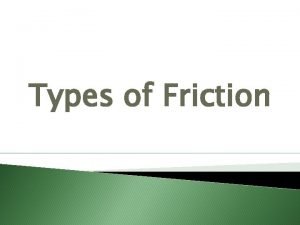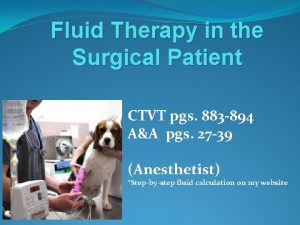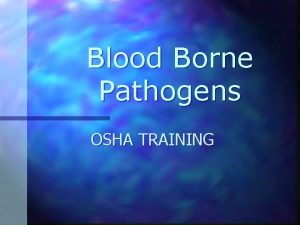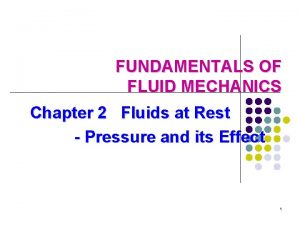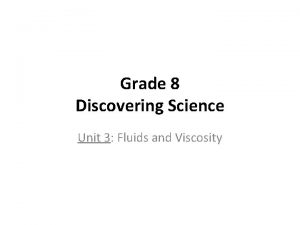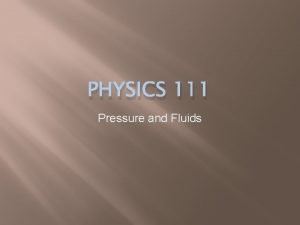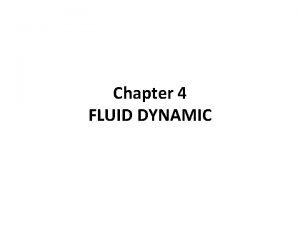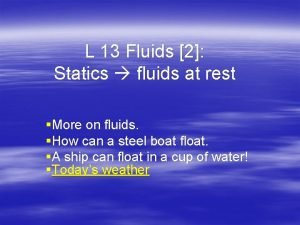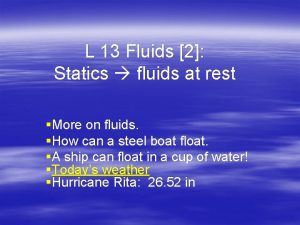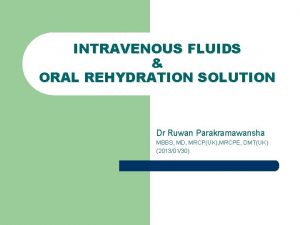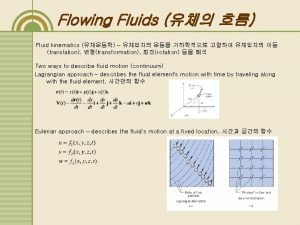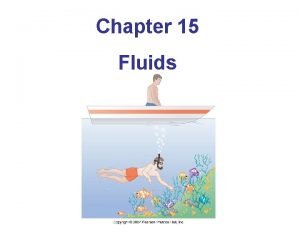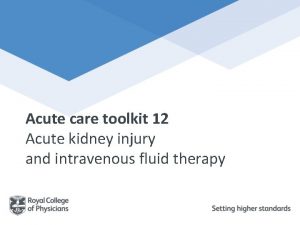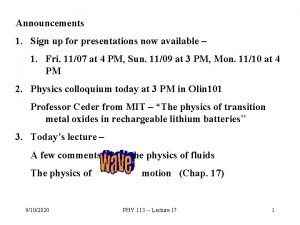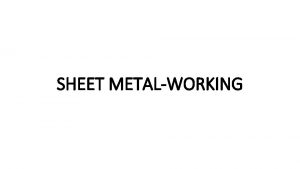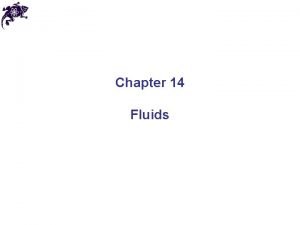Occupational Exposure to Metalworking Fluids Presented at the




















- Slides: 20

Occupational Exposure to Metalworking Fluids Presented at the Occupational Hygiene Association of Ontario Spring Symposium March 28, 2007 By Lorraine Shaw, B. Sc. , CIH, ROH Occupational and Environmental Health Laboratory, Mc. Master University

Outline l Overview l Types of MWF, Health Effects, Standards, Exposure Assessment l Objectives of the Study l Methodology l Selection of Plants, Laboratory Investigation, Field Investigation, QC and Statistics l Results l Laboratory and Field Results l Conclusions

Overview (I) Types of MWFs: l Oil-based: Health Effects: l Cancer – Insoluble (neat) l Hypersensitivity – Soluble (30% - 85% oil) Pneumonitis (HP) l Water-based: l Respiratory Effects – Semi-synthetic (5%-30% l Dermatitis oil) – Synthetic (no oil)

Overview (II) Regulations and Exposure Standards: Ontario Ministry of Labour: Oil, mineral, mist 5 mg/m 3 TWAEV, 10 mg/m 3 STEV ACGIH TLV-TWA (Mineral Oil) in 2006 notice of intended changes : Mineral Oil Used in metal working Poorly and mildly refined 0. 2 mg/m 3 (Inhalable) A 2 Highly and severely refined 0. 2 mg/m 3 (Inhalable) A 4 Proposed NIOSH REL for all types of MWF (1998): 0. 5 mg/m 3(Total) 0. 4 mg/m 3 (Thoracic) Exposure Assessment: Sampling Devices: ie. Total, Thoracic (BGI), IOM, Direct Reading Instrument (Dust. Trak) – Particle size selective sampling –

The Three Size Fractions

Objectives l Assess and Validate Analytical Methods l Assess Air Sampling Methods l Collect Current Representative Occupational Exposure Data l Assess Exposure Exceedance l Compare Ontario Exposure with Published Data (Mainly Water-Based MWF’s)

Methodology l Selection of 4 Plants in Ontario l Laboratory Investigation l Field Investigation l Quality Control and Statistical Analysis

Laboratory Investigation l NIOSH Method (0500) – Total Aerosol l NIOSH 5524 – Extractable MWFs l HSE Method (MDHS 95) – Marker Element l Sample Recovery l Detection Limits l Sample Stability During Storage

Field Investigation l Collection – Personal – Area of Air Samples l Size Selective Samples – Total – Thoracic (MMAD = 10 µm) – Respirable (MMAD = 4 µm) – Inhalable (MMAD = 100 µm) – Direct Reading Instrument (Dust. Trak)

Air Sampling Devices Dust. Trak Aerosol Monitor Direct Reading Instrument Total Sampler IOM Inhalable Sampler BGI 2. 69 Cyclone Thoracic Sampler Respicon Size-Selective Particle Sampler

Occupational Exposure

Examples of Machining Fluids

Examples of Finished Products

QC and Stats l QUALITY CONTROL – Laboratory – Field l STATISTICAL ANALYSIS – Excel and Minitab 13

Results: Laboratory Investigation l Sample Recovery – Our Study – NIOSH Study l Detection Limit – Our Study – NIOSH Study 83. 5% 95 % 35µg 28 µg l Storage Study (Sample Stability) – Room Temp – NOT Stable – Refrigerator – 2 days – Freezer – 7 days

Results: Airborne Concentrations (mg/m ) 3 • % Exceedance is based on log normal distribution ze = -log(GM/STD) / log(GSD)

Relationship of Total vs Thoracic

Conclusions (I) l HSE method proved problematic l Both NIOSH method 0500 or 5524 can be used l preferred method is the 5524 l Detection limits, sample recovery etc. were similar to NIOSH study l Samples should NOT be stored at Room Temp l Samples should be analyzed within 2 or 7 days depending on storage temperature

Conclusions (II) l Ratio of Thoracic to Total aerosol is about 0. 7 l Range of exposures in Ontario (0. 04 to 3. 84 mg/m 3) is similar to others (NIOSH & OSHA) l Percent exceedance based on data set and assumption of log normality is 38% with respect to NIOSH REL l Respiratory effects reported at levels below 0. 5 mg/m 3 l Total Protection requires AIR, DERMAL and FLUID management

Thank you This research study was funded by a grant from the WSIB
 Metalworking hand tool
Metalworking hand tool Guerin bending process
Guerin bending process Transaction exposure and economic exposure
Transaction exposure and economic exposure Managing economic exposure and translation exposure
Managing economic exposure and translation exposure Managing economic exposure and translation exposure
Managing economic exposure and translation exposure Eksposur translasi adalah
Eksposur translasi adalah Fluid friction.
Fluid friction. Crystalloids
Crystalloids Bio fluids
Bio fluids Multifluid manometer example
Multifluid manometer example Discovering science 8
Discovering science 8 Fluids physics problems and solutions
Fluids physics problems and solutions Fluid flow classification
Fluid flow classification Fluids at rest
Fluids at rest Eulers equation
Eulers equation Fluids at rest
Fluids at rest Hypotonic iv solution
Hypotonic iv solution Irrotational vortex
Irrotational vortex Static fluids
Static fluids Iv fluid classification
Iv fluid classification Physics of fluids
Physics of fluids






